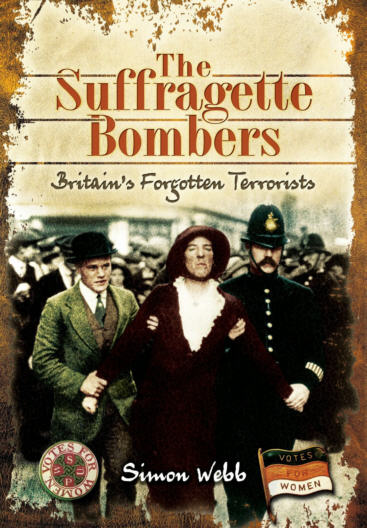
|
||
Excerpts fromThe Suffragette BombersBritain’s Forgotten TerroristsSimon WebbPen & Sword Books, Barnsley, 2014 |
The Edwardian World
We tend, as already remarked, to see Britain between Victoria’s death in 1901 and the outbreak of war in 1914 as a country at the height of imperial power, a nation enjoying stability and peace. In a sense, it was, but only by direct comparison with the slaughter of the trenches on the Western Front and the disruption of the world war which brought that period of British history to an end. Because of this, we have a distorted idea of how the suffragettes fitted into the scheme of things. We often think of them as radicals fighting against the stultifying complacency of a well-ordered and self-satisfied society.
According to this perception, a stubborn and reactionary government refused to take heed of the legitimate demands of disenfranchised women and so they were compelled to take direct action. The reality was that the governments of the day were fighting desperately to preserve peace and order, while simultaneously doing their best to raise the standard of living for average working men and women. They did this while fending off a succession of crises, some of which could have resulted in catastrophe for the country.
From the safe and comfortable perspective of the twenty-first century, the question of women’s votes appears to be an absurdly simple one: all that the prime minister of the day had to do was pass a law giving women the vote. In fact, as we have seen, the whole question of extending the parliamentary franchise beyond the limits which had been set by the Reform and Redistribution Acts of 1884-1885 was immensely complicated and no two groups even agreed upon the terms under which it should be undertaken.
The Liberal governments before the First World War found themselves, on more than one occasion, gazing into the abyss, facing the very real prospect of the violent disintegration of the United Kingdom and a state of affairs where the army might end up playing a role in political affairs. In addition to this, these administrations were preparing for the possibility, which became a stark reality in 1914, of a European war. If they were more concerned with tackling such matters and tended as a result to neglect the demands of a few hundred, largely middle-class women, it is possible in retrospect to understand their priorities. (pp. 26-27)
An Undemocratic Organisation
The expulsion from the WSPU of those who disagreed with or even merely questioned the views of Emmeline and Christabel Pankhurst continued. One of their most devoted supporters was Emmeline Pethick-Lawrence who had supported Emmeline Pankhurst during the rebellion in 1907. Five years later, in 1912, Emmeline Pethick-Lawrence and her husband Fred were horrified to learn that the WSPU was going to be taking even more extreme actions than the window-smashing and other vandalism which was already alienating so many potential supporters. They voiced this fear to Emmeline and Christabel, with the result that they too were dropped from the WSPU. Inevitably, the time came when Mrs Pankhurst began to turn against even her own family for their supposed treachery.
Sylvia Pankhurst, one of Emmeline’s other daughters, was a socialist and had many dealings with people such as George Lansbury and Keir Hardie. She set up a branch of the WSPU called the East London Federation, which attracted working-class women to the cause of women’s suffrage. Sylvia Pankhurst was also in favour of universal adult suffrage, rather than the equal suffrage which had for years been the official policy of the WSPU. This, together with her belief in the practice of democracy in her own organisation, led to her falling out with her mother and sister. This schism was, disturbingly, caused because they felt that she had too strong a belief in democracy. There is a touch of Alice in Wonderland about an organisation such as the WSPU being alarmed about the spread of grass roots democracy.
By 1914, Emmeline and Christabel Pankhurst had had enough of Sylvia’s flirtation with democracy. She was summoned to a meeting with them both, a meeting at which her sister did most of the talking, with her mother’s approval. Their main objection to Sylvia’s activities was plain. Christabel told her, ‘You have a democratic constitution for your federation, we do not agree with that.’ It further emerged that neither Emmeline nor Christabel Pankhurst approved of involving working-class women too much in the suffrage movement. Christabel said that their education was ‘too meagre to equip them for the struggle.’ She went on, ‘Surely it is a mistake to use the weakest for the struggle? We want picked women, the very strongest and most intelligent.’
It is impossible to avoid the feeling that the real objection to what Sylvia Pankhurst was doing was a combination of distrust of democracy and dislike of the working classes being treated as equals. These people needed strong leaders who would tell them what to do, without any of this democratic nonsense. Christabel then said to her sister, ‘You have your own ideas. We do not want that, we want all our women to take their instructions and walk in step like an army.’ (pp. 38-39)
Terrorist Payroll
Far from being a mass movement, the WSPU was a small group of activists who felt that they knew better than ordinary people what was good for them. When those ordinary people showed no enthusiasm for what was being suggested, a hard core of militants attempted to force agreement by the use of violence. The bombings and arson attacks were carried out in the main by paid workers from the WSPU and sanctioned by the leadership of the organisation, Mrs Pankhurst specifically endorsing both bomb attacks and fire-raising. (p. 52)